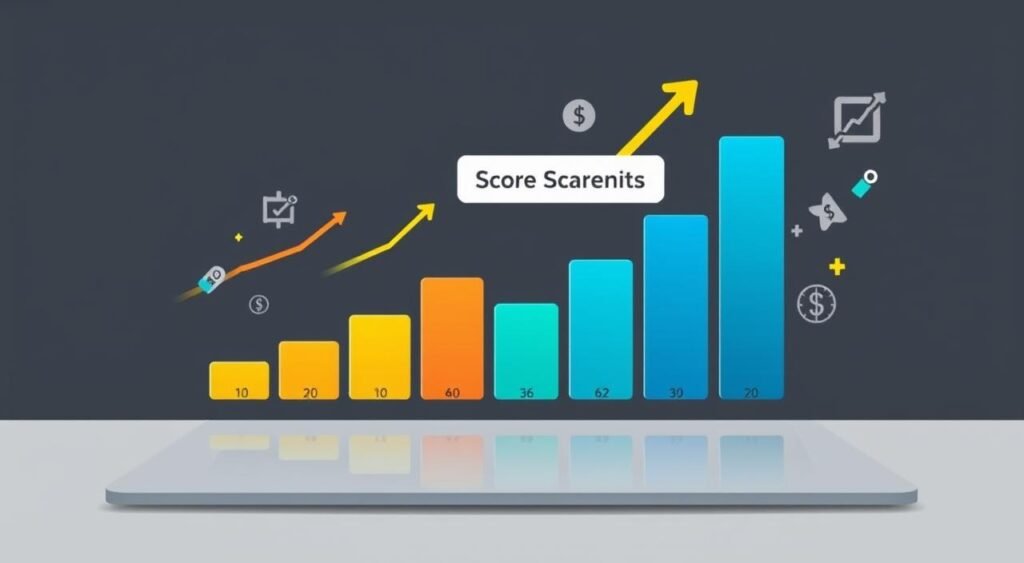Did you know a business’s Paydex score can greatly affect its ability to get financing and build strong vendor relationships? This three-digit number shows your company’s payment history and creditworthiness. Knowing your Paydex score is key for any business owner aiming to succeed.
In this guide, we’ll explore Paydex scores in detail. We’ll cover what they are, how they’re calculated, and why they’re important for your business. This info will help you manage your business credit and set your company up for success.
Key Takeaways
- Paydex scores range from 0 to 100, with higher scores showing less risk of late payments1.
- A score of 80 or above means you pay suppliers on time. Scores below 80 show late payments1.
- Paydex scores are dollar-weighted, so bigger payments affect the score more2.
- Businesses can get a Paydex score by getting a D-U-N-S number from Dun & Bradstreet2.
- Keeping a strong Paydex score is vital for getting business financing, building vendor relationships, and winning big contracts.
What is a Paydex Score?
A Paydex score is a business credit score from Dun & Bradstreet (D&B). It shows how well your company pays its suppliers and vendors3. Scores range from 0 to 100, with 0 being the highest risk of late payments3.
Paydex Score Meaning and Definition
The Paydex score is easy to grasp. It only looks at how well your business pays its suppliers and vendors3. A score above 80 means low risk for creditors and lenders, showing timely payments3.
To get an accurate score, you need at least three trade references3. Transactions from the last two years are used3. The score weighs larger payments more3.
Dun & Bradstreet says a score of 80-100 means low risk, with payments made on time3. Scores of 50-79 show medium risk, with payments 2-30 days late3. Scores of 0-49 indicate high risk, with payments 31-120 days late3. A lower score means a higher risk of late payment3.
The Paydex score helps businesses understand their creditworthiness4. It shows how lenders, suppliers, and customers see you4. A strong score can lead to better financing and trade credit terms4.
The Importance of Paydex Scores
Your Paydex score is very important for your business. Landlords might look at it when deciding if you can rent a place. Lenders check it to see if they should give you a loan or credit card. Suppliers use it to decide if they should offer you good payment terms5.
The Paydex score is from 1 to 100. A higher score means you pay bills on time5. To get a Paydex score, your business needs to have paid bills to at least four vendors5. A good Paydex score can help your business get better deals and opportunities5.
| Paydex Score Range | Interpretation |
|---|---|
| 80-100 | Good payment performance |
| 50-79 | Average payment performance |
| 0-49 | Poor payment performance |
The Paydex scoring system by Dun & Bradstreet checks if a business is creditworthy6. Scores range from 0 to 100. A score of 80 or higher is good for businesses6. Keeping a high Paydex score is key for your business’s financial health and growth.
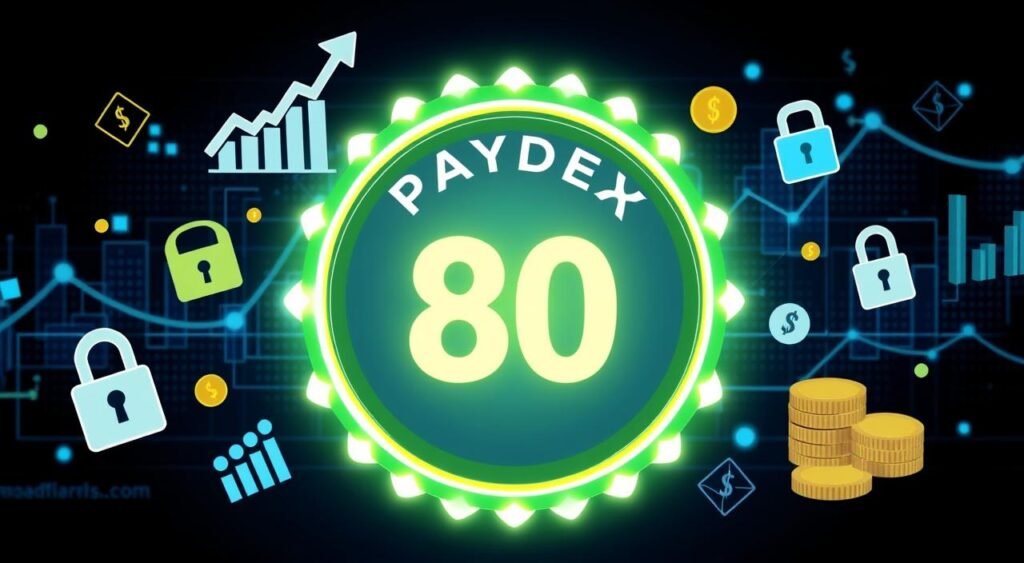
“Paydex is a credit scoring system developed by D&B to assess a business’s creditworthiness. It is primarily designed to help lenders, suppliers, and other entities evaluate the risk associated with extending credit or forming financial relationships with your business.”7
In short, a high Paydex score is crucial. It helps your business get better deals from landlords, lenders, and suppliers. It’s a key metric to watch and improve over time56.
Paydex Score Chart and Range
Knowing your Paydex score is key for any business. The Paydex score, made by Dun & Bradstreet, goes from 1 to 100. A higher score means better payment habits8. To get a Paydex score, a business must have payment records with at least four vendors8.
Interpreting Paydex Score Ranges
Paydex scores have different ranges, each showing how trustworthy your business is9.
- 1 to 49: This score is very high-risk, showing payments over 90 days late9.
- 50 to 79: It’s a medium-risk score, meaning payments were up to 30 days late9.
- 80 to 100: This is a low-risk score, showing payments were on time or early9.
A ‘good’ Paydex score is around 75, and 80 to 100 is even better9. It can take 3 to 6 months to get a Paydex score after getting a DUNS number9.
| Paydex Score Range | Payment Performance | Risk Level |
|---|---|---|
| 1 to 49 | Payments made 90 days late or more | High Risk |
| 50 to 79 | Payments made up to 30 days late | Medium Risk |
| 80 to 100 | On-time or early payments | Low Risk |
Keeping a high Paydex score can help with business financing. It shows you’re financially responsible9. By knowing the 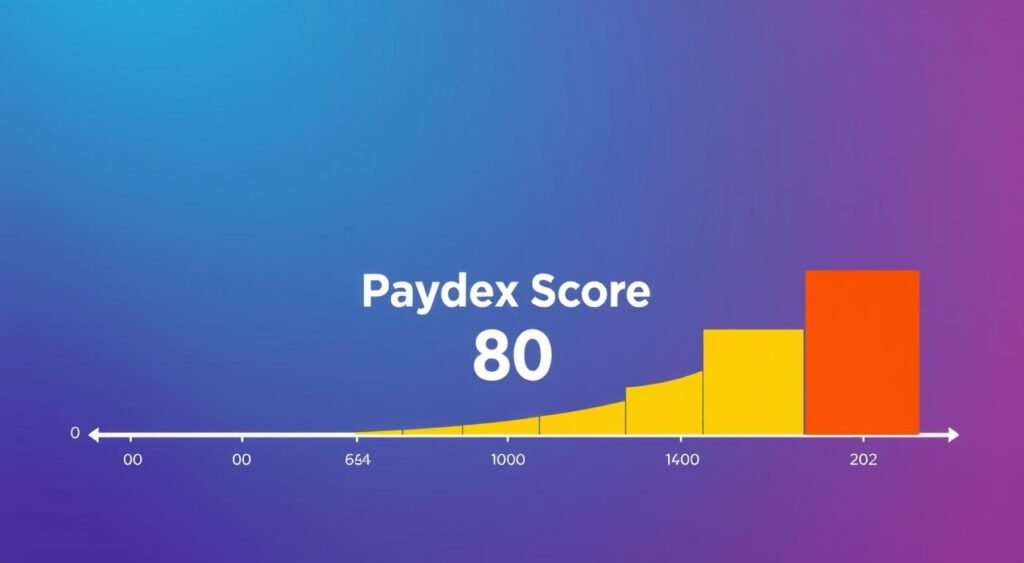 and your score range, you can improve your business’s credit9.
and your score range, you can improve your business’s credit9.
How Paydex Scores are Calculated
To get a Paydex Score, your business needs a D-U-N-S Number from Dun & Bradstreet (D&B). This is like a Social Security number for your company10. With a D-U-N-S Number, D&B can calculate your Paydex Score based on your suppliers’ payment experiences, or tradelines11.
D&B needs at least three payment experiences from two tradelines to give you a Paydex Score11. How timely and large your payments are matters a lot. Early and bigger payments help your score more11.
| Paydex Score | Payment Timeliness |
|---|---|
| 100 | Pays 30 days sooner than terms |
| 90 | Pays 20 days sooner than terms |
| 80 | Pays on due date |
| 70 | Pays 15 days beyond terms |
| 60 | Pays 22 days beyond terms |
| 50 | Pays 30 days beyond terms |
| 40 | Pays 60 days beyond terms |
| 30 | Pays 90 days beyond terms |
| 20 | Pays 120 days beyond terms |
| U/N | Unavailable/no payment |
The Paydex score goes from 1 to 100, with 1 being the worst and 100 the best. It shows how likely a business is to pay bills on time or early10. Aim for a score of at least 75 to be in good standing. A score of 80 means you pay bills on time10.
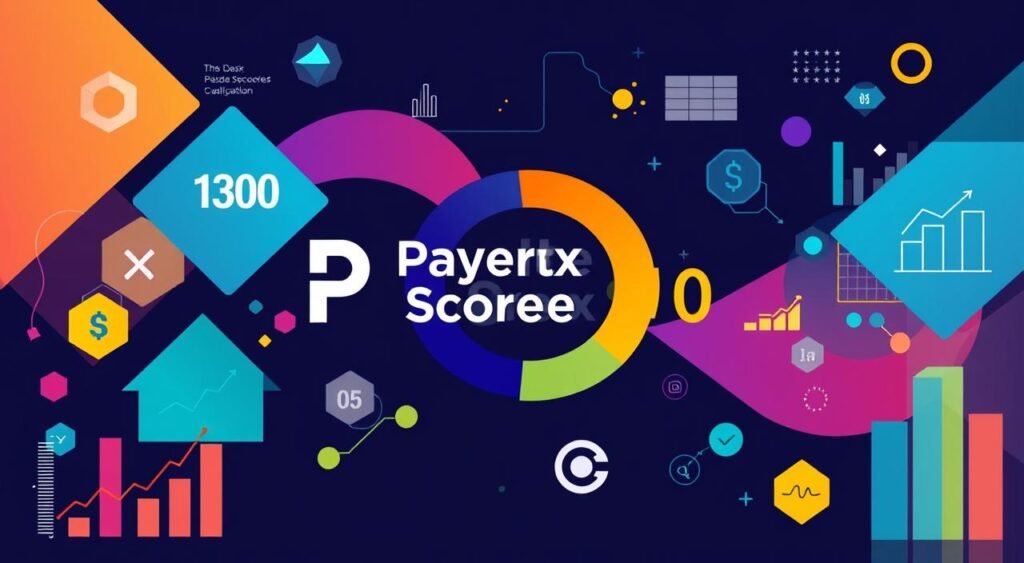
Dun & Bradstreet’s database has info on over 265 million companies in 200 countries as of 201310. It takes at least three months of payment experiences to get an initial Paydex score. To reach an 80 Paydex score, it may take 45-90 days of consistent payments11.
A score of 80 or higher can help your business get better financing. It can also lead to improved payment terms and attract partners and investors11.
Establishing a Paydex Score
To start building a strong Paydex score, get a D-U-N-S Number from Dun & Bradstreet12. This 9-digit number is key for Dun & Bradstreet to collect your payment data. It’s free, but you can pay extra for a quicker service.
After getting your D-U-N-S Number, Dun & Bradstreet will track your payments and give you a Paydex score12. To improve your score, make sure your suppliers report your payments on time12. You can also send your payment info to Dun & Bradstreet, but you must verify it first.
Paydex scores range from 1 to 100, with higher scores showing better payment habits12. A score of 80 or above is very good, and 100 is perfect12. But, a score of 1 means you might pay late12.
To get a Paydex score, you need payment records with at least four vendors13. Dun & Bradstreet looks at Trade References from up to 875 partners to score you12. For better advice, talk to business credit experts12.
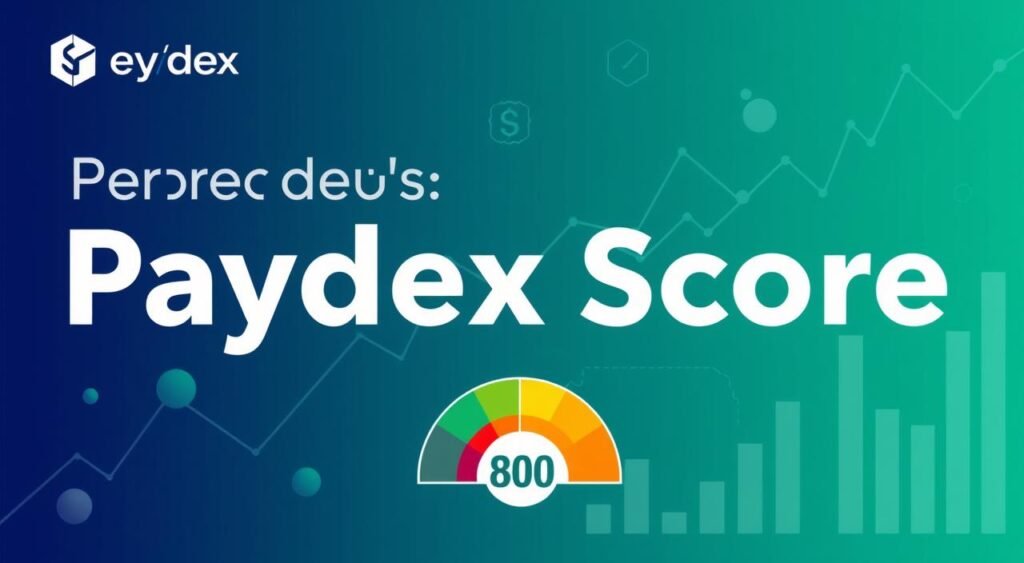
Factors Affecting Paydex Scores
Payment Timeliness and Dollar Amounts
Your Paydex score is mainly based on two things: how quickly and how much you pay suppliers and vendors11. Paying early boosts your score. Big payments help more than small ones. For instance, paying a $5,000 invoice early is better than a $500 one11.
To keep a good Paydex score, pay on time or early. This is key.
The Paydex score goes from 0 to 100, with higher numbers meaning better payment habits11. Scores of 80-100 are excellent, showing consistent or early payments11. Scores of 50-79 are fair to good, showing mostly on-time payments11. But, scores under 50 mean late payments or delinquencies11.
To get a Paydex score, you need at least two tradelines with three or more credit experiences11. The score is an average of your payment history over 12 months11. Paying off balances quickly and having a long history of timely payments can help your score11. Credit use and trade experience diversity also matter11.
The number of trade experiences for U.S. businesses has grown from 63M to 114M, an 82% jump14. The number of U.S. businesses with at least one trade has risen from 13M to 22M, a 69% increase14. Also, U.S. businesses with three or more trades have grown from 7M to 11M, a 57% increase14. Small businesses with one or more trades have increased by 72%, and those with three or more trades by 80%14.
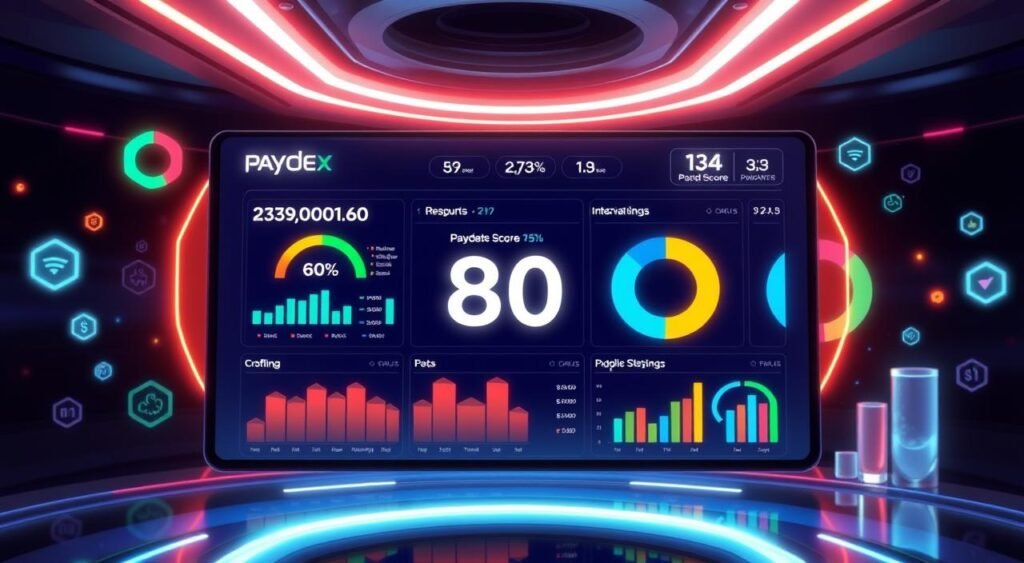
To get a Paydex score, you need a DUNS number. It takes at least three months of payment history for Dun & Bradstreet to give you a score11. Businesses with scores of 80 or above are seen as low-risk and very creditworthy11.
“Maintaining a strong Paydex score is crucial for your business, as it can influence lending decisions, vendor relationships, insurance underwriting, and even potential business partnerships.”
paydex score and Business Loans
Your business’s Paydex score is key for lenders when they look at loan applications. This score, from 0 to 100, shows your company’s payment history and creditworthiness15. A score of 80 or higher means you’re a reliable borrower. This can lead to better loan terms, like lower interest rates or more money to borrow16.
But, a score under 50 can make getting loans harder or lead to worse terms16. Lenders see a low score as a risk. This might mean higher interest rates, smaller loans, or even no loan at all.
To get the best financing, know how your Paydex score is figured and check it often. Keeping a good payment history and fixing any score issues can make you a more attractive borrower.
“A high Paydex score shows your business is creditworthy. It can lead to better loan terms, helping you grow.”
While your Paydex score is important, it’s not the only thing lenders look at. But, understanding and improving your score can help you get the loans your business needs to succeed.
Checking Your Business’s Paydex Score
Monitoring and Accessing Paydex Scores
It’s important to watch your business’s Paydex score closely. This score, from 1 to 100, shows how well your company pays bills17. You can see your Paydex score for free with D&B’s CreditSignal program for 14 days17.
After the free trial, you’ll need to pay for a monthly plan to keep an eye on your score. Or, you can use sites like Nav to check your score. But, they offer fewer options than personal credit scores18. Checking your score often helps you spot problems and fix them to boost your credit.
| Credit Score Provider | Score Range | Description | Subscription Cost |
|---|---|---|---|
| Dun & Bradstreet (PAYDEX) | 1-100 | Measures payment history | $149 per month (CreditBuilder Plus) |
| Experian | 1-100 | Assesses payment behavior | $39.95 per report or $179 per year |
| Equifax | 101-992 | Evaluates likelihood of delinquent payments | Free with business credit application, otherwise contact Equifax |
By regularly monitoring your paydex score, you can keep your company’s credit in good shape. This way, you can take steps to make it even better1817.
Improving a Low Paydex Score
If your business has a low Paydex Score, there are steps to improve your Paydex score. The key is to pay suppliers and vendors on time, or even early. This boosts your score, especially for big invoices1920.
It’s also vital to check if your suppliers and vendors report your payments to Dun & Bradstreet. You can send payment info to Dun & Bradstreet through their packages. But, you need to verify the data20.
- Make all payments to suppliers and vendors on time, or even earlier if possible.
- Ensure that your suppliers and vendors are reporting your timely payments to Dun & Bradstreet.
- Proactively submit payment information to Dun & Bradstreet through their credit-building packages.
By taking these steps, you can improve your Paydex score. This shows your business is creditworthy to lenders and partners1920.
“Paying bills early can lead to significant improvements in the PAYDEX rating; paying 10, 15, or 20 days earlier on substantial accounts can have a notable impact.”
Dun and Bradstreet Paydex Score Overview
D&B’s Role in Business Credit Scoring
Dun & Bradstreet (D&B) is a key player in business credit scoring. They create the Paydex score to check how quickly businesses pay their bills21. This score goes from 0 to 100, with 100 being the best. Lenders usually want a score of 70 or higher, seeing 80 or above as excellent21.
D&B rates businesses from 1 to 4, with 1 being the most trustworthy22. They also have a rating system from 5A for big companies to HH for smaller ones22. Every business gets a unique D-U-N-S Number for their credit reports22.
D&B offers services to help businesses improve their credit profiles. Prices range from $61.99 for the Credit Evaluator Plus to $189.00 for the Business Information Report On Demand22. To keep a good rating, businesses should use less credit, pay bills early, and have different types of credit22.
In short, Dun & Bradstreet is very important in business credit. They give insights and tools for smart business decisions. By knowing about the Paydex score and D&B’s role, businesses can work on their creditworthiness222123.
Alternative Business Credit Scores
While the PAYDEX Score from Dun & Bradstreet is well-known, other scores exist. Scores like the Experian Business Credit Score and the Equifax Business Credit Score assess creditworthiness differently. They use various data sources and methods24.
The Experian Business Credit Score ranges from 1 to 100. It looks at lines of credit, payment history, and personal credit history. A good score is between 76 and 10024.
The Equifax Business Credit Score uses the Equifax payment index and credit risk score. It also considers business failure score. Scores range from 892 to 992 for credit risk and 1400 to 1600 for business failure24.
Newer scores like the FICO SBSS and Tillful’s Business Health Score are also emerging. They look at real-time transactions and cash flow. These scores aim to give a more detailed view of a company’s creditworthiness25.
Businesses should know about these different scores. They help in understanding how others might view their creditworthiness. By learning about these scores, companies can improve their credit profiles and make better decisions26.
Conclusion
The PAYDEX Score is key for your business. It shows if you pay suppliers and vendors on time27. A good score opens doors to better deals and loans28. But a low score can make it hard to get good terms or new deals28.
Knowing how to improve your PAYDEX Score is important. It helps your business look good to lenders and partners27. By paying on time and keeping your finances in order, you can boost your score27.
The PAYDEX Score is from 0 to 100, with 80 or above being good27. A high score means you’re less risky to lenders27. Paying bills early can also help your score27.
Suppliers check your PAYDEX Score to decide on credit terms27. Regularly checking your credit report and keeping your finances healthy are key27.
The Paydex Score also affects your business’s payment terms and rates28. Things like payment history and business size matter28. A high score means you can get better deals and rates28.
Working with Net 30 vendors and using automated payments can help28. Keeping an eye on your score and references is also important28.
FAQ
What is a PAYDEX Score?
Why is the PAYDEX Score important?
What is the PAYDEX Score range?
How is the PAYDEX Score calculated?
How can I establish a PAYDEX Score?
What factors affect a PAYDEX Score?
How does a PAYDEX Score impact business loans?
How can I check and monitor my PAYDEX Score?
How can I improve a low PAYDEX Score?
What is Dun & Bradstreet’s role in the PAYDEX Score?
Are there other business credit scores besides the PAYDEX Score?
Source Links
- PAYDEX Score: The Only Ultimate Guide You Need To Read – https://www.forbes.com/advisor/credit-score/paydex-score/
- Understanding the Paydex Score – https://www.businessinsider.com/personal-finance/credit-score/what-is-paydex-score
- What Is A Paydex Score? | Bankrate – https://www.bankrate.com/credit-cards/business/what-is-paydex-score/
- PAYDEX Score: The Dun & Bradstreet Business Credit Rating – https://www.nav.com/business-credit-scores/dun-bradstreet-paydex/
- PAYDEX Business Credit Score: See What Yours Means – https://www.creditsuite.com/blog/decoding-the-paydex-business-credit-score/?srsltid=AfmBOooPPHnZzxmlD8_J_ZUOxZO7hffO-x-L-qFs1a3Pv4EFvyiAiXUt
- Paydex | HighRadius™ | Autonomous Finance | A/R Management Software – https://www.highradius.com/glossary/paydex-meaning-and-definition/
- Paydex Scores: Your Key to Small Business Financial Success. – https://www.paycron.com/blog/unlocking-financial-success-a-comprehensive-guide-to-paydex-scores-for-small-businesses
- PAYDEX Business Credit Score: See What Yours Means – https://www.creditsuite.com/blog/decoding-the-paydex-business-credit-score/?srsltid=AfmBOoq-zJ_L58o8Jzpvg-wtz_wGM0Jg1kAWZWVrKPSJkWkc1iRgQplL
- Paydex Score: Everything You Need to Know – https://paymentcloudinc.com/blog/paydex-score/
- Paydex Score: Breaking Down This Credit Score | Fundera – https://www.fundera.com/blog/paydex-score
- PAYDEX Score: The Dun & Bradstreet Business Credit Rating – https://ramp.com/blog/what-is-a-paydex-score
- D&B PAYDEX Score FAQ – Business Credit Score Guide – https://northshoreadvisory.com/business-credit/business-credit-scores/dnb-paydex-score-faqs/
- PAYDEX Business Credit Score: See What Yours Means – https://www.creditsuite.com/blog/decoding-the-paydex-business-credit-score/?srsltid=AfmBOoqIyO2E1JFmgMDqPTMvf1-iHLtaKC1ED16B31cxeYb8g_Yq47vi
- The PAYDEX score is calculated by the Trade algorithm which examines individual experiences, classifies them into various classes, weights them according to the dollar amounts for each category and then multiplies by the individual index weight to comput – https://docs.dnb.com/static/doc-uploads/supplier/en-US/support/FAQs.pdf
- Do Credit Checks Lower My Business Credit Score? | OnDeck – https://www.ondeck.com/resources/do-credit-checks-lower-my-business-credit-score
- What is PAYDEX Score | Gaviti – https://gaviti.com/glossary/paydex-score/
- How to Check Your Business Credit Score – NerdWallet – https://www.nerdwallet.com/article/small-business/how-to-check-your-business-credit-score
- How to Check Business Credit Scores and Reports | Nav – https://www.nav.com/blog/how-to-check-business-credit-431017/
- How to Get a PAYDEX Score of 80: The Essential Guide – https://www.unitedcapitalsource.com/blog/paydex-score-80/
- PAYDEX Scores Explained: What They Are and How They Affect Your Company’s Credit – https://www.fastcapital360.com/blog/what-is-paydex-score/
- The Dun and Bradstreet PAYDEX Business Credit Score – https://www.linkedin.com/pulse/dun-bradstreet-paydex-business-credit-score-paul-a-damiano-ege4e
- Dun & Bradstreet Rating: What Is It? | Seek Capital – https://www.seekcapital.com/blog/dun-bradstreet-rating
- How to Get an 80 PAYDEX Score | eCredable – https://business.ecredable.com/resources/blog/how-to-get-80-paydex-score
- How to Check Your Business Credit Score: PAYDEX Score & More – https://www.creditsuite.com/blog/how-to-check-your-business-credit/?srsltid=AfmBOoojZG0P4ugpiHdcAy-VyaJwKzyfNea6-2bfNfOsJM3e20ZmDfU1
- Check Free Business Credit Report/Credit Offers/Credit Score – Tillful – https://www.tillful.com/business-credit-score/
- Business Credit Scores: What They Are & How to Check Them – https://ramp.com/blog/101-guide-to-business-credit-scores
- Understanding the PAYDEX Score: Your Business’s Credit Score 📊🏢 – https://www.linkedin.com/pulse/understanding-paydex-score-your-businesss-credit-paul-a-damiano-l3t4e
- The Essential Guide to Understanding What is a Paydex Score and Net 30 Vendors – https://theceocreative.com/the-essential-guide-to-paydex-scores-and-net-30-vendors/

